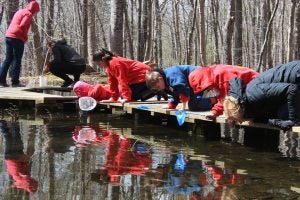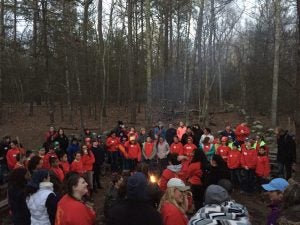


“One touch of Nature makes the whole world kind.” -William Shakespeare
On the afternoon of April 7th, the SMILE Program’s 5th grade students stepped off a school bus and onto the beautiful and peaceful grounds of URI’s W. Alton Jones Campus. They were welcomed by 21 URI mentors who spent the spring semester preparing themselves, activities and hands-on lessons to educate the SMILE students about the ecology of the W. Alton Jones Campus during their 3 day, 2-night stay. The SMILE students and URI mentors quickly bonded on Friday during their first field study, dinner, campfire and cabin talks before it was LIGHTS OUT for a restful sleep to prepare them for a full day of field studies, games, meals and another campfire on Saturday. The students and mentors spent the weekend together learning about the plant and animal life throughout the campus. The URI mentors not only captivated the SMILE students with their hands-on lessons at four different sites, they also led the students in fun campfire songs and shared their challenges and successes throughout their academic careers. The EOSA weekend was a rewarding, heartwarming and educational experience for all in attendance.
At the Bubbling Pond, URI mentors engaged the students by getting down and dirty in the mud to learn about macro-invertebrates and their importance in the ecosystem of the pond. At the pond, the students found adult salamanders, saw salamander egg masses and got wet while looking for life and/or evidence of life in the pond and identifying the different plants and animals they observed.
In the Pine Forest, URI mentors involved the students in learning not only about the massive Pine trees but also about the history of W. Alton Jones and how human impact allowed the students to observe succession in progress
and take a walk back in time. The Eastern White Pine trees were once under the possession of the British Crown and resulted in deforestation in New England. The students learned how to estimate tree height and diameter and how to determine if a tree had the preferred measurements of the British Navy to be used for building of their ships and ships’ masts.
At the vernal pool, students had the opportunity to see egg masses of both salamanders and wood frogs. URI
mentors taught the SMILE students about the life cycles of both species and spent some time exploring the area
for juvenile and adult salamanders and wood frogs. Students observed two different types of lichen and learned
the significance of the unique organisms.
Deep in the woods at one of the streams, URI mentors had the students determine if the stream was healthy by calculating its flow rate and looking for macroinvertebrates that are indicators of a healthy stream. The SMILE students carefully examined rotting logs and stumps for organisms that are essential for decomposition and the recycling of nutrients. At the stream, students saw how live and dead trees are microhabitats for species that range in size from microscopic to larger animals such as birds, squirrels and owls.
